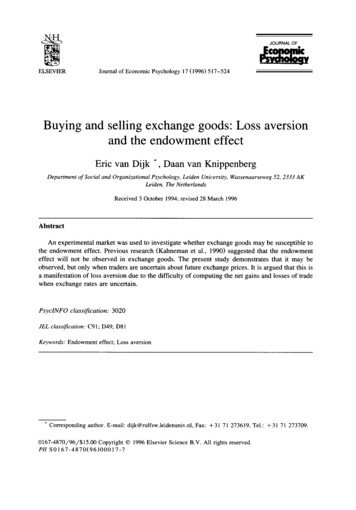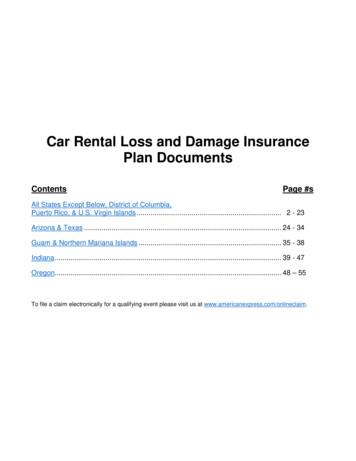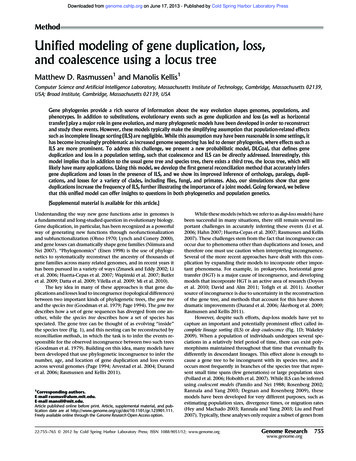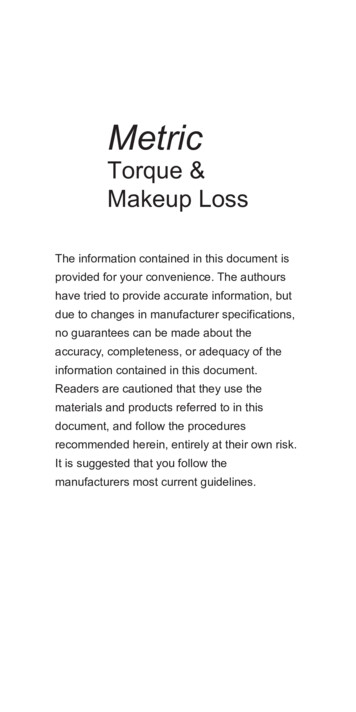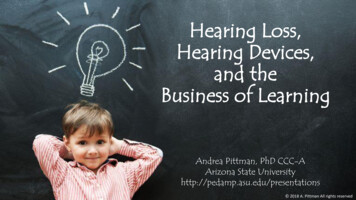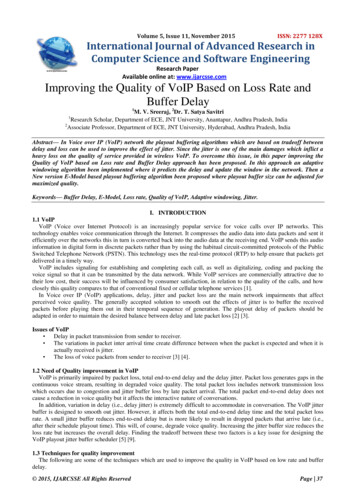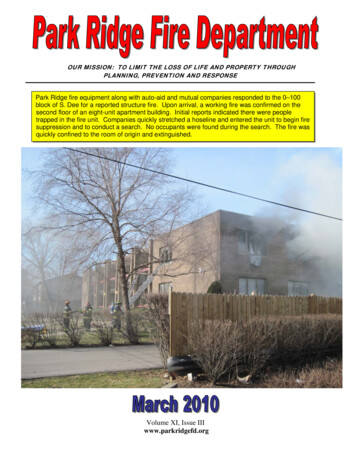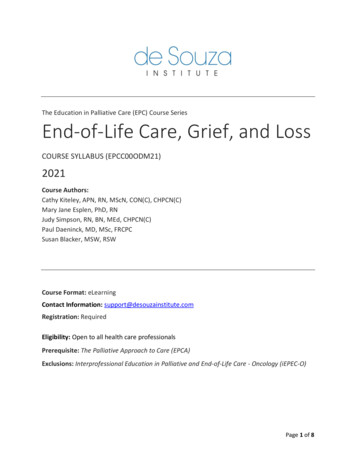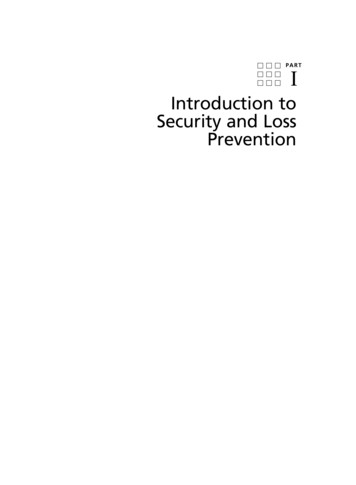
Transcription
PARTIIntroduction toSecurity and LossPreventionCh01-P2525.indd 19/29/2007 11:42:47 AM
Ch01-P2525.indd 29/29/2007 11:42:47 AM
1The History of Security andLoss Prevention: A CriticalPerspectiveObjectivesAfter studying this chapter, the reader will be able to:1.2.3.4.5.6.Explain the purpose of critical thinking and how to think critically.Define security and loss prevention.List the benefits of studying the history of security and loss prevention.Trace the early development of security and policing.Describe the growth of security companies in the United States.Explain the convergence of IT and physical security and the convergence of enterprisesecurity.7. Describe 21st century/post-9/11 security challenges.KEY TERMS critical thinkingsecurityloss preventionChief Security Officer (CSO)Great Wall of ChinaHammurabi, King of BabylonpolisPraetorian Guardvigilesfeudalismcomitatusposse comitatusPosse Comitatus Actfrankpledge systemtithingMagna CartaStatute of Westminster watch and wardHenry FieldingBow Street RunnersSir Robert PeelMetropolitan Police ActAllan PinkertonHenry WellsWilliam FargoWilliam BurnsWashington Perry BrinkEdwin HolmesGeorge Wackenhutfirst wave societiessecond wave societiesthird wave societiesconvergence of IT and physical securityconvergence of enterprise security3Ch01-P2525.indd 39/29/2007 11:42:47 AM
4THE HISTORY OF SECURITY AND LOSS PREVENTION: A CRITICAL PERSPECTIVEWhy Critical Thinking?September 11, 2001, marked a turning point in the history of security. In a devastating terrorist onslaught, knife-wielding hijackers crashed two airliners into the World Trade Centerin New York City, creating an inferno that caused the 110-story twin skyscrapers to collapse. About 3,000 people were killed, including responding firefighters and police. Duringthe same morning, another hijacked airliner crashed into the Pentagon, causing additionaldeaths and destruction. A fourth hijacked airliner failed to reach its target and crashed whenheroic passengers learned of the other attacks and struggled with hijackers to control theairliner. The attacks were immensely successful and cost-effective for the terrorists. With aloss of 19 terrorists and expenses between 400,000 and 500,000, the attackers were ableto kill thousands, cause hundreds of billions of dollars in economic damage and spendingon counterterrorism, and significantly affect global history. With such a huge kill ratio andinvestment payoff for the terrorists, governments and the private sector must succeed incontrolling terrorism.Because of these devastating attacks, not only have homeland defenses, military strategies,public safety, and private sector security changed, but also our way of thinking has changed. Wecannot afford to have failures in our planning and imagination of what criminals can do. Toimprove security, we must seek new tools to assist us in our thinking processes.Here we begin with critical thinking skills to counter “business as usual.” Criticalthinking helps us to become active learners: to not only absorb information, but to probe andshape knowledge. The critical thinker cuts through “hype” and emotion and goes beyond collecting “facts” and memorizing information in an effort to understand causes, motives, andchanges. Critical thinking skills provide a foundation for creative planning while helping usto anticipate future events.The critical thinker asks many questions, and the questions are often easier to formulate than the answers. Critical thinking requires us to “jump out of our own skin” to see theworld from the perspective of others. Although this is not an easy process, we are much betterinformed before we make our conclusions and decisions.Critical thinking is not to be used as a tool to open up the floodgates of criticism in theworkplace. It is to be applied discreetly to understand the world and to meet challenges.A professional’s success depends on his or her thinking process applied to everydayduties and long-range planning. Critical thinking adds an extra edge to the repertoire of toolsavailable to security and loss prevention practitioners.Safi and Burrell (2007: 54) write:Theorists have hypothesized that critical thinking is correlated with internal motivation to think. Cognitive skills of analysis, interpretation, explanation, evaluation andcorrecting one’s ownreasoning are at the heart of critical thinking.Critical thinking can be learned with practice and guidance by changing theactions involved in making decisions so that they become part of permanentbehavior in homeland security intelligence analysis, threat protection and securityplanning.Security challenges have become increasingly complex because as we plan for protection and face a multitude of threats in a rapidly changing environment, we must expect theunexpected, while staying within our budgets. The security practitioner should be creative,have an excellent imagination, apply critical thinking skills, and carefully prioritize securitystrategies to produce the best possible security program.Although critical thinking skills are applied to a critical perspective of history in thischapter, students and practitioners are urged to continue this thinking process throughout thisbook. It is hoped that your conclusions and decisions will be enhanced to improve securityand loss prevention.Ch01-P2525.indd 49/29/2007 11:42:47 AM
Why Think Critically about the History of Security and Loss Prevention?5To prime the reader’s mind for the explanation of critical thinking, Chapter 3 appliescritical thinking to security planning by suggesting that all security strategies be placedunder one of the following three models: it protects people and assets; it accomplishesnothing; or it helps offenders.How Can We Think Critically?Our world is filled with many efforts to influence our thinking. Examples are the media,advertisers, politicians, educators, and writers. This author is biased just like other writers,and within these pages is a North American interpretation of security. Although an effort hasbeen made to write an objective book here, it is impossible for any writer, and biases surface. Objectivity is fostered in this book through an introduction to critical thinking skills, amultidisciplinary approach, international perspectives, boxed topics and questions, a varietyof references, Web exercises, and case problems at the end of chapters that bridge theory topractice and ask the reader to make decisions as a practitioner.With so much competition seeking to influence us, choices become difficult and confusing. And, as we think through complex challenges, we need a method of sorting conflictingclaims, differentiating between fact and opinion, weighing “evidence” or “proof,” beingperceptive to our biases and those of others, and drawing logical conclusions. Ellis (1991:184–185) suggests a four-step strategy for critical thinking:Step 1: Understand the point of view. Listen/read without early judgment. Seek to understand the source’s background (e.g., culture, education, experience, andvalues). Try to “live in their shoes.” Summarize their viewpoint.Step 2: Seek other views. Seek viewpoints, questions, answers, ideas, and solutions from others.Step 3: Evaluate the various viewpoints. Look for assumptions (i.e., an opinion that something is true, without evidence),exceptions, gaps in logic, oversimplification, selective perception, either/or thinking,and personal attacks.Step 4: Construct a reasonable view. Study multiple viewpoints, combine perspectives, and produce an original viewpointthat is a creative act and the essence of critical thinking.Why Think Critically about the History of Securityand Loss Prevention?The intent here is to stimulate the reader to go beyond memorizing historical events, names,and dates. If you have read several books in this field, the history chapters sound very similar.Did the writers, including this one, become complacent and repeat what has been writtenrepeatedly about the history of this field? How do you know that the history of security andloss prevention as presented in this book and in others is objective?Recorded history is filled with bias. Historians and scholars decide what subjects,events, innovations, countries, ethnic groups, religions, men, and women should be includedor excluded from recorded history. In reference to the history of security and loss prevention,Ch01-P2525.indd 59/29/2007 11:42:47 AM
6THE HISTORY OF SECURITY AND LOSS PREVENTION: A CRITICAL PERSPECTIVEwhat have we missed? What subjects have been overemphasized? (A case problem at the endof this chapter asks the reader to critically think about the history of security and loss prevention.) In the policing field, for example, Weisheit, Baker, and Falcone (1995: 1) note thathistory and research reflect a bias toward urban police, at the expense of rural police. Dosecurity researchers and writers overemphasize large proprietary security programs and largesecurity service firms? What about the thousands of proprietary security programs at smallcompanies and the thousands of small security service firms? Another question is what roledid women and minorities play in the history of this field?What country do you think has had the most impact on police and security in the UnitedStates? Our language, government, public and private protection, law, and many other aspectsof our lives have deep roots in England. However, what about the role of other countries inthe development of police and private security methods? Stead (1983: 14–15) writes of theFrench as innovators in crime prevention as early as the 1600s under King Louis XIV. Duringthat time, crime prevention was emphasized through preventive patrol and street lighting.Germann, Day, and Gallati (1974: 45–46) write of early Asian investigative methods that usedpsychology to elicit confessions.A critical thinking approach “opens our eyes” to a more objective perspective of historical events. The author is not seeking to rewrite history, or to change the basic strategies ofsecurity and loss prevention. Rather, the aim is to expand the reader’s perception and knowledge as a foundation for smarter protection in a complex world.Security and Loss Prevention DefinedWithin our organized society, security is provided primarily by our armed forces, law enforcement agencies, and private security. The 9/11 attacks resulted in several changes in the wayin which we organize public and private security. Post-9/11 security changes are covered insubsequent chapters.During the last decades of the 20th century, the methods of private security becamemore specialized and diverse. Methods not previously associated with security emerged asimportant components of the total security effort. Security officers, fences, and alarms havebeen the hallmark of traditional security functions. Today, with society becoming increasinglycomplex, additional specialization—auditing, safety, fire protection, information technology(IT) security, crisis management, executive protection, terrorism countermeasures, to name afew—continuously are being added to the security function. Because of the increase in diversespecializations within the security function, many practitioners favor a broader term for allof these functions, known as loss prevention.Another reason for the growing shift in terminology from security to loss preventioninvolves the negative connotations of security. Saul Astor (1978: 27) points out:In the minds of many, the very word “security” is its own impediment. Security carries a stigma; the very word suggests police, badges, alarms,thieves, burglars, and some generally negative and even repellent mental images .Simply using the term “loss prevention” instead of the word “security” can bea giant step toward improving the security image, broadening the scope of thesecurity function, and attracting able people.Because of additional specialization included in the security function and the frequentlynegative connotations associated with the term security, the all-encompassing term for describing the contents of this book is loss prevention. The security function and other specialized fields(auditing, safety, fire protection, etc.) are subsumed in loss prevention.Security is narrowly defined as traditional methods (security officers, fences, and alarms)used to increase the likelihood of a crime-controlled, tranquil, and uninterrupted environmentfor an individual or organization in pursuit of objectives.Loss prevention is broadly defined as almost any method (e.g., security officers, safety, auditing) used by an individual or organization to increase the likelihood of preventing and controllingloss (e.g., people, money, productivity, materials) resulting from a host of adverse occurrencesCh01-P2525.indd 69/29/2007 11:42:48 AM
History7(e.g., crime, fire, accident, natural disaster, error, poor supervision or management, bad investment). This broad definition provides a foundation for the loss prevention practitioner whoseinnovations are limited only by his or her imagination. It is hoped that these concepts not only willguide the reader through this book but also reinforce a trend in the use of these definitions.Various employment titles are applied to individuals who perform security and lossprevention duties within organizations. The titles include Vice President, Director, or Managerof Security, Corporate Security, Loss Prevention, or Assets Protection.Another title receiving attention is the Chief Security Officer (CSO). The Chief SecurityOfficer Guideline (ASIS International, 2004) is designed “ as a model for organizations toutilize in the development of a leadership function to provide a comprehensive, integratedsecurity risk strategy to contribute to the viability and success of the organization.” Thisguideline is a response to an increasingly serious threat environment, and it recommends thatthe CSO report to the most senior level executive of the organization. The guideline lists specific risks, job duties and services, and skills required. The CSO designation and the guidelinesupporting it provide an excellent reference from which the security profession and seniormanagement can draw on to improve the protection of people and assets and help organizations survive in a world filled with risks.CSO (2004) defines the CSO position as follows:The title Chief Security Officer (CSO) was first used principally inside the information technology function to designate the person responsible for IT security. Atmany companies, the term CSO is still used in this way. CISO, for Chief InformationSecurity Officer, is an equivalent term, and today the CISO title is becoming moreprevalent for leaders with an exclusive infosecurity focus.The CSO title is also used at some companies to describe the leader of the“corporate security” function, which includes the physical security and safety ofemployees, facilities and assets. More commonly, this person holds a title such asVice President or Director of Corporate Security. This function has historicallybeen distinct from information security.Increasingly, Chief Security Officer means what it sounds like: The CSOis the executive responsible for the organization’s entire security posture, bothphysical and digital.Research conducted by Booz Allen Hamilton (2005) for ASIS International, theInformation Systems Security Association, and the Information Systems Audit and ControlAssociation, found that placing all security functions under one individual (“the strongestor most powerful of the various security elements”) may not be beneficial (“an obviousand flawed option”) for all organizations because it can reduce the influence of importantmanagers in enterprisewide security. The study recommended a “business-focused council ofleaders” consisting of representatives from various specializations—such as risk management,law, safety, and business continuity—who “come together using the corporate strategy as acommon element on which to focus.”Security is narrowly defined; loss prevention is broadly defined.HistoryWhy Study the History of Security and Loss Prevention?We should study the history of security and loss prevention because We learn of the origins of the profession and how it developed. We can see how voids in security and safety within society were filled by the private sector.Ch01-P2525.indd 79/29/2007 11:42:48 AM
8THE HISTORY OF SECURITY AND LOSS PREVENTION: A CRITICAL PERSPECTIVE We can learn of noted practitioners and theorists and their challenges, failures, andsuccesses. We can compare security in the past to security in the present to note areas ofimprovement and areas requiring improvement. We can learn how security services and systems have been controlled and regulated. We can learn of the interaction of private security and public police over time. History repeats itself. We should strive to avoid the mistakes of the past and continuewith successes. We can learn how social, economic, political, and technological forces have affectedsecurity over time. The past assists us in understanding the present, and it offers us a foundation toanticipate future events.Early CivilizationsPrehistoric human beings depended on nature for protection because they had not learned howto build strong houses and fortifications. In cold climates, caves provided protection and shelter, whereas in the tropics, trees and thickets were used. Caves were particularly secure becauserocky walls guarded tribes on all sides except at the cave mouth. To protect the entrance, redundant (i.e., duplicating to prevent failure) security was employed: large rocks acted as barrierswhen they were rolled in front of entrances; dogs, with their keen sense of smell, served to alarmand attack; and fires added additional defense. By living on the side of a mountain with accessvia a narrow, rocky ledge, cave dwellers were relatively safe from enemies and beasts. EarlyPueblo Indians, living in what is now New Mexico and Arizona, ensured greater protection forthemselves in their dwellings by constructing ladders that could be pulled in, and this defenseproved useful until enemies attacked with their own ladders. In fact, in early civilizations, astoday, security measures have never been foolproof, and adversaries typically strive to circumvent (i.e., to go around) defenses.Throughout history, redundant security has been used to block adversaries attempting tocircumvent defenses.The Great Wall of China is the longest structure ever built. It was constructed overhundreds of years beginning in the 400s BC. Hundreds of thousands of workers lived theirlives near the wall and participated in this huge project that stretched 4,000 miles and reachedheights of 25 feet. Unfortunately, the wall provided protection only from minor attacks; whena major invasion force struck, the defense could not withstand the onslaught. The army ofMongol leader Genghis Khan swept across the wall during the AD 1200s and conqueredmuch of China. Since 1949, the Chinese government has restored some sections of the mostlycollapsed wall, which is a major tourist attraction (Feuerwerker, 1989: 373–374).It is interesting to note the changing character of security through history. In earlier years,huge fortifications could be built with cheap labor, and a king could secure a perimeter withmany inexpensive guards. Today, physical barriers such as fences and walls are expensive, asis the posting of security forces at physical barriers. One 24-hour post can cost over 100,000annually for security personnel and physical security systems.As societies became more complex, the concepts of leadership, authority, and organization began to evolve. Mutual association created social and economic advantages but alsoinequities, so people and assets required increased protection. Intergroup and intragroupconflicts created problems whose “solutions” often took the form of gruesome punishments,Ch01-P2525.indd 89/29/2007 11:42:48 AM
Early Civilizations9including stoning, flaying, burning, and crucifying. A person’s criminal record was carried right on his or her body, through branding and mutilation. By 1750 BC the laws ofHammurabi, King of Babylon, not only codified the responsibilities of the individual to thegroup and the rules for private dealings between individuals, but also discussed retributivepenalties (Germann, Day, and Gallati, 1974: 43).Ancient GreeceBetween the ninth and third centuries BC, ancient Greece blossomed as an advanced commercialand culturally rich civilization. The Greeks protected their advancing civilization with the polis, orcity-state, which consisted of a city and the surrounding land protected by a centrally built fortressoverlooking the countryside. A stratified society brought the ruling classes constant fear of revolution from below. Spartans, for example, kept their secret agents planted among the lower classesand subversives. During the time of the Greek city-states, the first police force evolved to protectlocal communities, although citizens were responsible for this function. The Greek rulers did notview local policing as a state responsibility, and when internal conflicts arose, they used the army.During this era, the Greek philosopher Plato introduced an advanced concept of justice, in whichan offender not only would be forced to pay a sort of retribution, but also would be forced into amethod of reform or rehabilitation.Ancient Egyptians sealed the master locksmith in the tomb to prevent security leaks.Ancient RomeThe civilization of ancient Rome also developed both commercially and culturally before thebirth of Christ. Rome was located only 15 miles from the sea and could easily share in thetrade of the Mediterranean. This city sat on seven hills overlooking the Tiber River, whichpermitted ease in fortification and defense. A primitive but effective alarm system was usedby placing geese at strategic locations so their very sensitive hearing would trigger squawkingat the sound of an approaching army.The Roman regime was well designed to carry on the chief business of the Romanstate, which was war. A phalanx of 8,000 foot-soldiers became the basic unit of a Romanarmy equipped with helmets, shields, lances, and swords. Later, a more maneuverablelegion of 3,600 men armed in addition with iron-tipped javelins was used. These legionsalso were employed to maintain law and order. The first emperor of Rome, Augustus(63 BC–AD 14), created the Praetorian Guard to provide security for his life and property.These urban cohorts of 500 to 600 men were deployed to keep the peace in the city. Somebelieve that after about AD 6 this was the most effective police force until recent developmentsin law enforcement. Modern-day coordinated patrolling and preventive security began withthe subsequent nonmilitary vigiles, night watchmen who were active in both policing andfirefighting (Post and Kingsbury, 1977; Ursic and Pagano, 1974).The Romans have an interesting history in fire protection. During the 300s BC, slaveswere assigned firefighting duties. Later, improved organization established divisions encompassing hundreds of people, who carried water in jars to fires or brought large pillows sovictims trapped in taller structures could jump with improved chances for survival. Thecompletion of the aqueducts to Rome aided firefighting by making water easier to obtain.Hand pumps and leather hoses were other innovations.The Middle Ages in EuropeDuring the Dark Ages, the period in history after the destruction of the ancient Greek and Romanempires, feudalism gradually developed in Europe. Overlords supplied food and security to thoseCh01-P2525.indd 99/29/2007 11:42:48 AM
10THE HISTORY OF SECURITY AND LOSS PREVENTION: A CRITICAL PERSPECTIVEwho farmed and provided protection around castles fortified by walls, towers, and a drawbridgethat could be raised from its position across a moat. Even then, security required registration,licensing, and a fee—Henry II of England (reigned AD 1154–1189) destroyed more than 1,100unlicensed castles that had been constructed during a civil war (Brinton, et al., 1973: 167).Another mutual arrangement was the war band of the early Germans, the comitatus,by which a leader commanded the loyalty of followers, who banded together to fight and winbooty. To defend against these bands of German barbarians, many landowners throughoutEurope built their own private armies. (The term posse comitatus denotes a body of citizens thatauthority can call on for assistance against offenders. The Posse Comitatus Act is a Civil War–era act that generally prohibits the military from engaging in civilian law enforcement. This lawhas been labeled as archaic because it limits the military from responding to disasters.)Much of the United States’ customs, language, laws, and police and security methods canbe traced to its English heritage. For this reason, England’s history of protection is examinedhere.Between the 7th and 10th centuries, the frankpledge system and the concept of tithing fosteredincreased protection. The frankpledge system, which originated in France and spread to England,emphasized communal responsibility for justice and protection. The tithing, or group of 10 families,shared the duties of maintaining the peace and protecting the community.In 1066, William, Duke of Normandy (in present-day France), crossed the EnglishChannel and defeated the Anglo-Saxons at Hastings. A highly repressive police system developed under martial law as the state appropriated responsibility for peace and protection.Community authority and the tithing system were weakened. William divided England into55 districts, or shires. A reeve, drawn from the military, was assigned to each district. (Today,we use the word sheriff, derived from shire-reeve.) William is credited with changing thelaw to make a crime an offense against the state rather than against the individual and wasinstrumental in separating police from judicial functions. A traveling judge tried the cases ofthose arrested by the shire-reeves.In 1215 King John signed the Magna Carta, which guaranteed civil and political liberties. Local government power increased at the expense of the national government, and community protection increased at the local level.Another security milestone was the Statute of Westminster (1285), issued by KingEdward I to organize a police and justice system. A watch and ward was established to keepthe peace. Every town was required to deploy men all night, to close the gates of walled townsat night, and to enforce a curfew.What similarities can you draw between security strategies of earlier civilizations andthose of today?More Contemporary TimesEnglandFor the next 500 years, repeated attempts were made to improve protection and justice inEngland. Each king was confronted with increasingly serious crime problems and cries fromthe citizenry for solutions. As England colonized many parts of the world and as trade andcommercial pursuits brought many people into the cities, urban problems and high crimerates persisted. Merchants, dissatisfied with the protection afforded by the government, hiredprivate security forces to protect their businesses.By the 18th century, the Industrial Revolution compounded urban problems. Manycitizens were forced to carry arms for their own protection, because a strong governmentpolicing system was absent. Various police and private security organizations did strive toCh01-P2525.indd 109/29/2007 11:42:48 AM
More Contemporary Times11reduce crime; Henry Fielding, in 1748, was appointed magistrate, and he devised the strategy of preventing crime through police action by helping to form the famous Bow StreetRunners, the first detective unit. The merchant police were formed to protect businesses, andthe Thames River police provided protection at the docks. During this period, more than 160crimes, including stealing food, were punishable by death. As pickpockets were being hanged,others moved among the spectators, picking pockets.Do you think policing and justice were impotent during the early Industrial Revolutionin England? Do you think we have a similar problem today in the United States?Peel's ReformsIn 1829, Sir Robert Peel worked to produce the Metropolitan Police Act that resulted ina revolution in law enforcement. Modern policing was born. Peel’s innovative ideas wereaccepted by Parliament, and he was selected to implement the act that established a full-time,unarmed police force with the major purpose of patrolling London. Peel is credited also withreforming the criminal law by limiting its scope and abolishing the death penalty for morethan 100 offenses. It was hoped that such a strategy would gain public support and respect forthe police. Peel was very selective in hiring his personnel, and training was an essential part ofdeveloping a professional police force. Peel’s reforms are applicable today and include crimeprevention, the strategic deployment of police according to time and location, a command oftemper rather than violent action, record keeping, and crime news distribution.Although Sir Robert Peel produced a revolution in law enforcement in 1829, crime andthe private security industry continued to grow.Early AmericaThe Europeans who colonized North America had brought with them the heritage of their mothercountries, including various customs of protection. The watchman system and collective responsesremained popular. A central fortification in populated areas provided increased security from hostile threats. As communities expanded in size, the office of sheriff took hold in the South, whereasthe functions of constable and watchman were the norm in the Northeast. The sheriff’s dutiesinvolved apprehending offenders, serving subpoenas, and collecting taxes. Because a sheriff waspaid a higher
Introduction to Security and Loss Prevention I PART CCh01-P2525.indd 1h01-P2525.indd 1 99/29/2007 11:42:47 AM/29/2007 11:42:47 AMFile Size: 584KB
